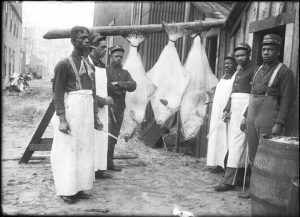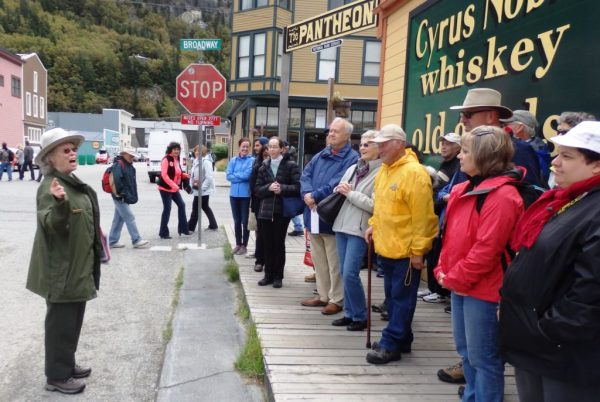
It’s a seldom-told story that’s now in the spotlight. That’s because Alaska’s most-visited national park is part of a nationwide effort to make the parks relevant to an increasingly diverse America.
“Skagway in 1898 was a pretty rough place,” said park ranger Charlotte Henson on a recent walking tour. She displayed black-and-white photos of Gold-Rush-era Skagway for a couple dozen tourists.
Henson told the story of Alaska territorial governor John Brady writing a plea to the capital.
“He said to Washington, ‘the Lynn Canal is full of gamblers, thugs and loose women. Send help,’” said Henson.
And help was sent.
“Company L of the 24th United States Infantry was stationed here for three years, from 1899 to 1901,” said Ben Hayes, chief of interpretation for Klondike Gold Rush National Historical Park.
Company L was an all-black regiment sent from San Francisco to the booming mining settlement of Dyea. A few weeks later they moved to the nearby town of Skagway.
“They lived their lives here and in many cases we found that they were not only serving their country and completing that mission as soldiers of the United States, but they were also fighting on a second front,” Hayes said. “And that was a war of discrimination and bigotry,” said Hayes.
Back on the walking tour, Henson leads the group to a busy street across from the historical YMCA building to tell one of those stories of discrimination. She reads from a newspaper clipping from 1900:
“It said ‘Line Drawn: Objections Arise to Colored Men in YMCA. Withdrawals Made,’” said Henson.

Racial discrimination is a constant thread throughout American history. But until this summer, that piece of Skagway’s history was mostly unexamined and untold.
Why is the story being brought to forefront now? The National Park Service is concerned about the disparity between the people who visit parks and the American population as a whole. Park visitors are overwhelmingly older and white.
“If we have a large segment of the country that’s growing that does not feel that national parks are important or special or for them, then that really can endanger our mission and make it difficult for us to achieve stewardship and preservation of these places for future generations,” Hayes said.
The park service has decided that to remain relevant, they have to find a way to appeal to a more diverse audience. That’s what prompted the Klondike Park to apply for a federal grant aimed at preservation of the Civil Rights Movement.
The park was the only one in Alaska to receive such a grant this year. The $22,000 appropriation motivated Hayes to do something unusual. Normally, the rangers who give tours get to choose what they focus on. But this year, he required them to research and give talks about Company L – Skagway’s Buffalo Soldiers.
“I hated the idea. I didn’t feel like I had enough information,” said ranger Henson. “And so I was kicking and screaming, I might’ve been one of the last ones to get my walk done.”
But now, Henson says she’s realized how important it is to tell this story — one that’s been relegated to background for so long.
“They helped to make our society the way it is today,” she said. “And we need to be aware that it’s just not white people that have done everything in this country,” said Henson.
Unlike the Soapy Smiths of Skagway, there’s not a lot of information available about the men of Company L. Henson describes it as a puzzle the rangers are slowly piecing together.
“We don’t know what they thought about Skagway, we really don’t know what Skagway thought about them,” said Henson.
Michigan resident Sharon Williams is one of about 30 people who followed along on Henson’s tour.
“I knew about the Buffalo Soldiers, I didn’t know they came as far north as Alaska,” Williams said at the end of the walk.
Williams is on a high school reunion cruise. She says her Virginia school was segregated until her senior year. Williams says she did not expect to hear tales of Civil Rights on her cruise to the 49th state.
“I thought it was very well done and I just appreciate, she said they have to try to put the pieces of this puzzle together,” Williams said. “It’s a start.”
It’s a start: a sentiment Ben Hayes echoes.
“I think we’ve just scratched the surface,” Hayes said.
The rangers have been working this summer to track down a living descendant of Company L in hopes that family stories will shed light on these men.
Additionally, the Klondike Park hopes to keep Skagway’s Buffalo Soldiers in the spotlight beyond this summer. Hayes plans to apply for the same grant funding next year to continue telling visitors about this little-known piece of history.
Emily Files is a reporter at KHNS in Haines.




